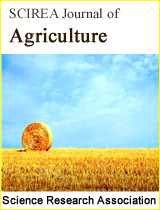Bacterial community metagenomic and variation of some medicinal plant rhizosphere collected form Sinai
DOI: 497 Downloads 16976 Views
Author(s)
Abstract
The rhizosphere microbes play an important role in improving medicinal values of medicinal plants. The role of microbes in plant growth, nutrient availability, disease resistance, yield and quality of medicinal compounds is demonstrated in medicinal plants. There are increasing interests in the research of the interaction between medicinal plant and their rhizosphere microbes for the improvement of medicinal plants. Dry Rhizosphere of medicinal plants collected form Sinai, Egypt and water treated represents a common physiological stress for the microbial communities residing in surface of these medicinal plants. A dry and wetting by water induce lysis in a significant proportion of the microbial biomass and, for a number of reasons, Effect directly or indirectly on microbial community composition. In this study Dry sand and water treated as common stress in the laboratory by exposing three different rhizosphere immersed in water to 10 day and 20 day period.
The three rhizospheric medicinal plants were collected from Saint Katherine Mountain, Sinai, Egypt. Bacterial community of dry and immersed with distilled water were evaluated every 10 day of incubation. Total DNA was extracted from sand samples and characterized its bacterial communities using the terminal restriction fragment length polymorphism method and degrading gradient Gel electrophoresis. This work revealed that water changed bacterial community in all samples compared with dry sand due to water may induced shifts in bacterial community. Bacterial community clone library of Capparis spinosa rhizosphere were studied and phylogenetic tree of bacterial community were evaluated.
Keywords
Microbial fingerprint, bacterial community, TRFLP, medicinal plants, soil DNA extraction, 16S ribosomal RNA
Cite this paper
M. A. El-Badry, Mohamed Ali El-Badry Hafez Amin,
Bacterial community metagenomic and variation of some medicinal plant rhizosphere collected form Sinai
, SCIREA Journal of Agriculture.
Volume 1, Issue 1, October 2016 | PP. 16-34.
References
| [ 1 ] | Dunbar, J., L.O. Ticknor & C.R. Kuske. 2001. Phylogenetic specificity and reproducibility and new method for analysis of terminal restnct10n fragment profiles of 16S rRNA genes from bacterial communities. Applied and Environmental Microbiology 67:190-197 |
| [ 2 ] | Fierer, N., J.P. Schimel & P.A. Holden. 2003. Influence of drying-rewetting frequency on soil bacterial community structure. Microbial Ecology 45:63-71. |
| [ 3 ] | Garbeva, P., van Veen, J.A., van Elsas, J.D. 2004. Microbial diversity in soil: selection microbial populations by plant and soil type and implications for disease suppressiveness. Annu. Rev. Phytopathol. 42:243–270. |
| [ 4 ] | Gupta M, Bisht S, Singh B, Gulati A, Tewari R (2011) Enhanced biomass and steviol glycosides in Stevia rebaudiana treated with phosphate-solubilizing bacteria and rock phosphate. Plant Growth Regul 65:449–457 |
| [ 5 ] | Kirk, JL., Beaudette, L.A., Hart, M., Moutoglis, P., Klironomos, J.N., Lee, H., Trevors, J.T. 2004. Methods of studying soil microbial diversity. J Microbiol Methods. 58:169–188. |
| [ 6 ] | Mosallam HAM. 2007 – Assessment of target species in Saint Katherine Protectorate, Sinai, Egypt. Journal of Applied Sciences Research 3, 456-459. |
| [ 7 ] | Murugappan RM, Begum SB, Roobia RR (2013) Symbiotic influence of endophytic Bacillus pumilus on growth promotion and probiotic potential of the medicinal plant Ocimum sanctum. Symbiosis 60:91–99 |
| [ 8 ] | Narula N, Kothe E, Behl RK (2009) Role of root exudates in plant-microbe interactions. J Appl Bot Food Qual 82:122–130 |
| [ 9 ] | Nema, R., Khare, S., Jain P, Pradhan A, Gupta A, Singh D (2013) Natural products potential and scope for modern cancer research. Am J Plant Sci 4:1270–1277 |
| [ 10 ] | Toussaint JP, Smith FA, Smith SE (2007) Arbuscular mycorrhizal fungi can induce the production of phytochemicals in sweet basil irrespective of phosphorus nutrition. Mycorrhiza 17:291–297 |
| [ 11 ] | Zengler, K., Walcher, M., Clark, G., Haller, I., Toledo, G., Holland, T., Mathur, E.J., Woodnutt, G., Short, J.M., Keller, M. 2005. High-throughput cultivation of microorganisms using microcapsules. Methods Enzymol. 397:124–130. |

